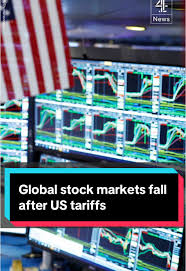Following the big news of the imposition of reciprocal tariffs announced by the President of the United States, it has been reported today that the US stock market index known as the Dow Jones has dropped. Specifically, the index fell by an estimated amount of 1,400 points, which equates to a drop of approximately 3%, and eventually dropped to the level of 40,800.
At the same time, the S&P 500 index has seen a drop of approximately 220 points or approximately 4%. The index has declined to a point of 5,450, which is a huge change in the market. The Nasdaq Composite meanwhile is trading and has seen a sharp drop with a high of 860 points, which means a drop of approximately 5%.
The market value of the United States financial sector has experienced a major drop, falling by approximately $2 trillion.
Due to this sudden drop, the total market capitalization of the United States stock market has seen a sharp decline, and it is estimated to be around $2 trillion. Specifically, the market capitalization of the S&P 500 index was $47.681 trillion on April 2; however, this amount has now dropped to around $45.921 trillion as of April 3.
3 Reasons for the US Market Downturn
Concerns About Lower Profits for Companies: The United States government has just implemented a minimum tariff rate of 10% to be imposed on all imported goods, and strict tariffs on certain countries, such as a huge 34% tariff on goods imported from China and an even higher 46% tariff on goods imported from Vietnam. As a direct result of these tariffs, the cost of goods imported from these subject countries will certainly increase. The increased costs for companies that rely on these imports will then have a corresponding impact on their overall profitability. Due to these concerns about potentially lower profits, investors have already begun to act on this by selling stocks, a practice that is partly responsible for the apparent collapse of the financial market.
The shadow of a spectacular global trade war hangs over the global economic landscape: in response to the United States’ tariff announcement, there is a very real chance that other countries could retaliate by announcing their own retaliatory tariffs in return. To put this into perspective, if the United States announced a substantial 27% tariff on imports from India, there is a very high chance that India would retaliate by raising tariffs on US products as well, and thus up the stakes. This tit-for-tat tariff game has the potential to severely hamper global trade, which in turn would adversely affect the complex supply chain networks that prevail between nations. As a direct result of this growing uncertainty in global trade policies, investors are becoming progressively worried and panicked, and have thus begun withdrawing massive amounts of money from the stock market.
The fear of a possible economic recession has already begun to make its presence felt among analysts and the public as well. If commodities and goods prove to be more expensive due to the tariffs that have come into effect, it is likely that their consumption will be reduced by consumers, ensuring that overall economic activity slows down. Furthermore, as a direct result of the lower demand across various segments, crude oil prices have also taken a sharp blow, with US crude now being sold at $69.63 per barrel. This sharp price weakness is a clear indication of reduced economic activity and market participation. Due to these alarming trends, investor confidence has clearly been shaken, and the downward momentum seen in the market has only gained momentum, resulting in even more alarm.
Mutual tariffs are set to be implemented from April 9
A 10% baseline (minimum) tariff will be imposed on all imports to the US. The baseline tariff will be implemented on April 5 and the reciprocal tariff will be implemented after midnight of April 9. The baseline tariff is imposed on imports under the normal rules of trade, while the reciprocal tariff is imposed in retaliation to the other country’s tariff.
The US will impose a massive tariff of 26% on Indian imports
In a formal speech on the new tariff measures, US President Donald Trump clearly expressed his stance by stating that India charges a high tariff rate of 52% on US goods and services. In response to this, he said that the United States will charge a 26% tariff on Indian imports. This implies that the tariff charged by the United States will be about half of what other nations are charging us for the same imports. Therefore, it should be noted that these tariffs will not be exactly reciprocal, i.e., they will not be of the same proportion. President Trump used the occasion to discuss India’s Prime Minister, Narendra Modi. He acknowledged that Modi is indeed his good friend but expressed his dissatisfaction by saying that Modi is not behaving in a civilized manner with the United States.
Read Also:
- US President Big Claim, India Agrees To Reduce Tariff: US Will Impose Tit For Tat Tax From Tomorrow; China, Japan, South Korea United Against It
- America Will Impose Tit For Tat Tariff From Today: Trump Will Announce It At The Make America Wealthy Again Event; Israel Removes Custom Duty On American Products
- America Imposed 26% Tit For Tat Tariff On India: Trump Said- Modi Is A Good Friend, But Is Not Behaving Properly; New Tariffs Will Be Implemented From April 9
- The Role Of Money In The Financial System
- Bitcoin Money
- Artificial Money And Its Lifecycle
- Historical background Of Money
- Demerits / Disadvantages Of Money
- The History Of Money
- Evolution Of Money








Leave a Reply